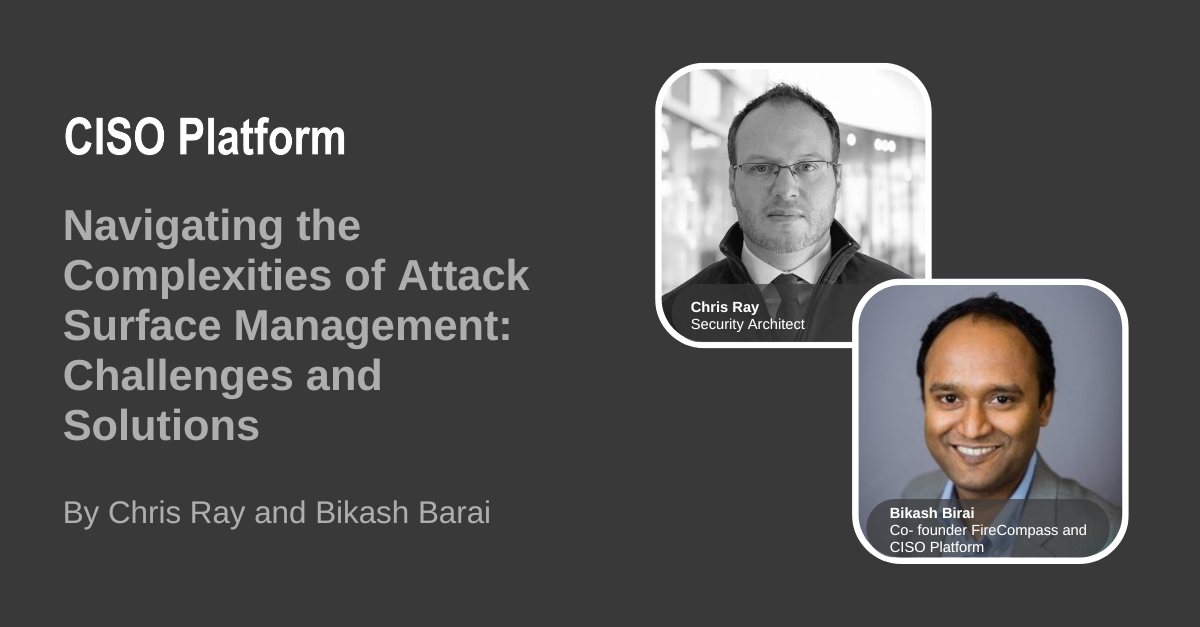In the dynamic landscape of cybersecurity, the process of Attack Surface Management (ASM) emerges as a critical endeavor, particularly in the realm of mergers and acquisitions (M&A). As businesses undergo transformative changes and expand their portfolios through M&A activity, the technical business units face unprecedented challenges in assessing and securing newly acquired assets. Legacy tools and bespoke scripts fall short in meeting the demands of this evolving landscape, underscoring the need for innovative solutions that can adapt to the complexities of modern cybersecurity. In this blog, we explore the challenges posed by M&A activity, the prevalence of false positives in ASM, and the transformative capabilities that define the future of attack surface management.
Here is the verbatim discussion:
Just about every business unit in a large Enterprise is involved in m&a activity it's especially hard on the technical business units so it networking infrastructure uh storage Cloud identity management uh and then security they all have to assess this newly acquired company Discover it completely and then design and make plans to get it up to the security standard of the company that's acquiring it their company how do you do that with with Legacy tools that are out there or or bespoke scripts or an army of Engineers that would miss stuff so it's very important that as an industry we don't get complient um and and uh another point which I wanted to add Chris is the false positives what's your thoughts on false positives because ASM largely um a lot of the ASM players like they they rely on the passive reconnaissance right like so what's your thoughts on false positive as a challenge yeah and that's a that's a great point to bring up we can't leave the the discussion of attack surface management with talking about without talking about one of the key capabilities that makes attack surface management so unique and so powerful uh and again starting with an example Legacy vulnerability management scanning tools think of those names those logos that you can picture in your your mind's eye those are doing their best to discover across the network what might exist on the endpoint and there's inferences assumptions
Highlights:
The Complexity of M&A Integration: As M&A activity becomes increasingly prevalent across industries, technical business units are tasked with the daunting challenge of integrating newly acquired companies into existing security frameworks. Networking infrastructure, storage, cloud services, identity management, and security all undergo rigorous assessment and redesign to meet the security standards of the acquiring company. Legacy tools and manual processes prove inadequate in this fast-paced environment, highlighting the urgent need for streamlined solutions that can efficiently manage the expanded attack surface.
False Positives: Navigating the Noise: False positives emerge as a significant challenge in ASM, particularly in passive reconnaissance methods. Traditional vulnerability management tools rely on network scans and endpoint assessments, often leading to inaccuracies and missed vulnerabilities. The abundance of false positives not only hampers the efficacy of security teams but also contributes to alert fatigue and operational inefficiencies. Addressing this challenge requires a paradigm shift towards more precise and context-aware approaches to vulnerability detection.
The Power of Context-Aware Solutions: At the heart of ASM lies a transformative capability that sets it apart from legacy tools: context awareness. Unlike traditional vulnerability management solutions, ASM leverages passive reconnaissance methods to gather comprehensive insights into the organization's attack surface. By analyzing DNS records, certificate data, and public repositories, ASM provides unparalleled visibility into potential vulnerabilities, empowering security teams to prioritize and mitigate risks with precision and efficiency.
As organizations navigate the complexities of modern cybersecurity, the role of Attack Surface Management emerges as a linchpin in securing digital assets and mitigating risks. By addressing the challenges posed by M&A integration and false positives head-on, ASM solutions pave the way for a more resilient and proactive approach to cybersecurity. Through context-aware methodologies and innovative technologies, security teams can gain a deeper understanding of their attack surface, enabling them to adapt and evolve in the face of evolving threats. As the cybersecurity landscape continues to evolve, ASM stands poised to lead the charge towards a safer, more secure digital future.
Speakers:
Chris Ray, a seasoned professional in the cybersecurity field, brings a wealth of experience from small teams to large financial institutions, as well as industries such as healthcare, financials, and tech. He has acquired an extensive amount of experience advising and consulting with security vendors, helping them find product-market fit as well as deliver cyber security services.
Bikash Barai is credited for several innovations in the domain of Network Security and Anti-Spam Technologies and has multiple patents in USPTO. Fortune recognized Bikash among India’s Top 40 Business Leaders under the age of 40 (Fortune 40-under-40).Bikash is also an active speaker and has spoken at various forums like TiE, RSA Conference USA, TEDx etc.
Earlier he founded iViZ an IDG Ventures-backed company that was later acquired by Cigital and now Synopsys. iViZ was the first company in the world to take Ethical Hacking (or Penetration Testing) to
the cloud.


Comments